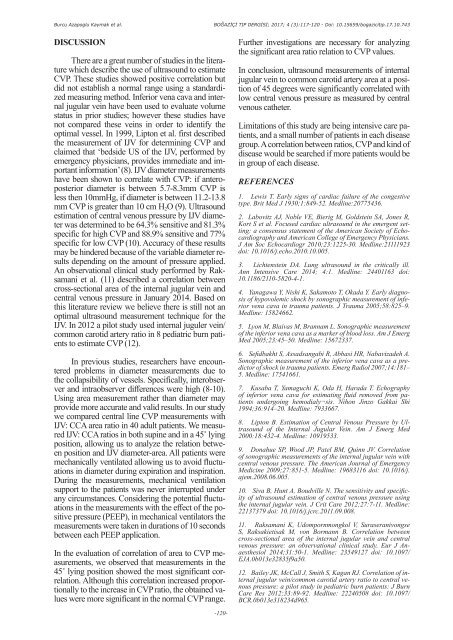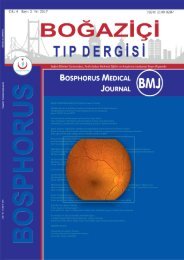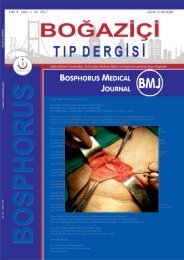2017-4-3
Create successful ePaper yourself
Turn your PDF publications into a flip-book with our unique Google optimized e-Paper software.
Burcu Azapoglu Kaymak et al.<br />
BOĞAZİÇİ TIP DERGİSİ; <strong>2017</strong>; 4 (3):117-120 - Doi: 10.15659/bogazicitip.17.10.743<br />
DISCUSSION<br />
There are a great number of studies in the literature<br />
which describe the use of ultrasound to estimate<br />
CVP. These studies showed positive correlation but<br />
did not establish a normal range using a standardized<br />
measuring method. Inferior vena cava and internal<br />
jugular vein have been used to evaluate volume<br />
status in prior studies; however these studies have<br />
not compared these veins in order to identify the<br />
optimal vessel. In 1999, Lipton et al. first described<br />
the measurement of IJV for determining CVP and<br />
claimed that ‘bedside US of the IJV, performed by<br />
emergency physicians, provides immediate and important<br />
information’ (8). IJV diameter measurements<br />
have been shown to correlate with CVP: if anteroposterior<br />
diameter is between 5.7-8.3mm CVP is<br />
less then 10mmHg, if diameter is between 11.2-13.8<br />
mm CVP is greater than 10 cm H 2 O (9). Ultrasound<br />
estimation of central venous pressure by IJV diameter<br />
was determined to be 64.3% sensitive and 81.3%<br />
specific for high CVP and 88.9% sensitive and 77%<br />
specific for low CVP (10). Accuracy of these results<br />
may be hindered because of the variable diameter results<br />
depending on the amount of pressure applied.<br />
An observational clinical study performed by Raksamani<br />
et al. (11) described a correlation between<br />
cross-sectional area of the internal jugular vein and<br />
central venous pressure in January 2014. Based on<br />
this literature review we believe there is still not an<br />
optimal ultrasound measurement technique for the<br />
IJV. In 2012 a pilot study used internal juguler vein/<br />
common carotid artery ratio in 8 pediatric burn patients<br />
to estimate CVP (12).<br />
In previous studies, researchers have encountered<br />
problems in diameter measurements due to<br />
the collapsibility of vessels. Specifically, interobserver<br />
and intraobserver differences were high (8-10).<br />
Using area measurement rather than diameter may<br />
provide more accurate and valid results. In our study<br />
we compared central line CVP measurements with<br />
IJV: CCA area ratio in 40 adult patients. We measured<br />
IJV: CCA ratios in both supine and in a 45˚ lying<br />
position, allowing us to analyze the relation between<br />
position and IJV diameter-area. All patients were<br />
mechanically ventilated allowing us to avoid fluctuations<br />
in diameter during expiration and inspiration.<br />
During the measurements, mechanical ventilation<br />
support to the patients was never interrupted under<br />
any circumstances. Considering the potential fluctuations<br />
in the measurements with the effect of the positive<br />
pressure (PEEP), in mechanical ventilators the<br />
measurements were taken in durations of 10 seconds<br />
between each PEEP application.<br />
In the evaluation of correlation of area to CVP measurements,<br />
we observed that measurements in the<br />
45˚ lying position showed the most significant correlation.<br />
Although this correlation increased proportionally<br />
to the increase in CVP ratio, the obtained values<br />
were more significant in the normal CVP range.<br />
Further investigations are necessary for analyzing<br />
the significant area ratio relation to CVP values.<br />
In conclusion, ultrasound measurements of internal<br />
jugular vein to common carotid artery area at a position<br />
of 45 degrees were significantly correlated with<br />
low central venous pressure as measured by central<br />
venous catheter.<br />
Limitations of this study are being intensive care patients,<br />
and a small number of patients in each disease<br />
group. A correlation between ratios, CVP and kind of<br />
disease would be searched if more patients would be<br />
in group of each disease.<br />
REFERENCES<br />
1. Lewis T. Early signs of cardiac failure of the congestive<br />
type. Brit Med J 1930;1:849-52. Medline:20775436.<br />
2. Labovitz AJ, Noble VE, Bierig M, Goldstein SA, Jones R,<br />
Kort S et al. Focused cardiac ultrasound in the emergent setting:<br />
a consensus statement of the American Society of Echocardiography<br />
and American College of Emergency Physicians.<br />
J Am Soc Echocardiogr 2010;23:1225-30. Medline:21111923<br />
doi: 10.1016/j.echo.2010.10.005.<br />
3. Lichtenstein DA. Lung ultrasound in the critically ill.<br />
Ann Intensive Care 2014; 4:1. Medline: 24401163 doi:<br />
10.1186/2110-5820-4-1.<br />
4. Yanagawa Y, Nishi K, Sakamoto T, Okada Y. Early diagnosis<br />
of hypovolemic shock by sonographic measurement of inferior<br />
vena cava in trauma patients. J Trauma 2005;58:825–9.<br />
Medline: 15824662.<br />
5. Lyon M, Blaivas M, Brannam L. Sonographic measurement<br />
of the inferior vena cava as a marker of blood loss. Am J Emerg<br />
Med 2005;23:45–50. Medline: 15672337.<br />
6. Sefidbakht S, Assadsangabi R, Abbasi HR, Nabavizadeh A.<br />
Sonographic measurement of the inferior vena cava as a predictor<br />
of shock in trauma patients. Emerg Radiol 2007;14:181–<br />
5. Medline: 17541661.<br />
7. Kusaba T, Yamaguchi K, Oda H, Harada T. Echography<br />
of inferior vena cava for estimating fluid removed from patients<br />
undergoing hemodialy¬sis. Nihon Jinzo Gakkai Shi<br />
1994;36:914–20. Medline: 7933667.<br />
8. Lipton B. Estimation of Central Venous Pressure by Ultrasound<br />
of the Internal Jugular Vein. Am J Emerg Med<br />
2000:18:432-4. Medline: 10919533.<br />
9. Donahue SP, Wood JP, Patel BM, Quinn JV. Correlation<br />
of sonographic measurements of the internal jugular vein with<br />
central venous pressure. The American Journal of Emergency<br />
Medicine 2009;27:851-5. Medline: 19683116 doi: 10.1016/j.<br />
ajem.2008.06.005.<br />
10. Siva B, Hunt A, Boudville N. The sensitivity and specificity<br />
of ultrasound estimation of central venous pressure using<br />
the internal jugular vein. J Crit Care 2012;27:7-11. Medline:<br />
22137379 doi: 10.1016/j.jcrc.2011.09.008.<br />
11. Raksamani K, Udompornmongkol V, Suraseranivongse<br />
S, Raksakietisak M, von Bormann B. Correlation between<br />
cross-sectional area of the internal jugular vein and central<br />
venous pressure: an observational clinical study. Eur J Anaesthesiol<br />
2014;31:50-1. Medline: 23549127 doi: 10.1097/<br />
EJA.0b013e32835f9a50.<br />
12. Bailey JK, McCall J, Smith S, Kagan RJ. Correlation of internal<br />
jugular vein/common carotid artery ratio to central venous<br />
pressure: a pilot study in pediatric burn patients: J Burn<br />
Care Res 2012;33:89-92. Medline: 22240508 doi: 10.1097/<br />
BCR.0b013e318234d965.<br />
-120-





